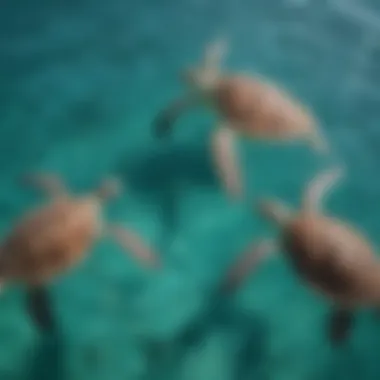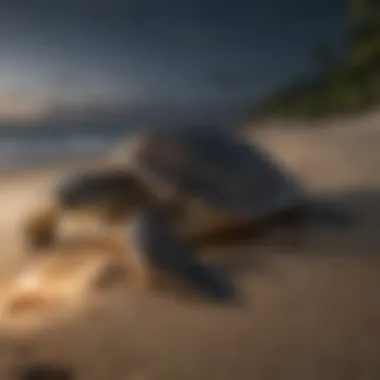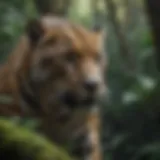The Crucial Role of Green Sea Turtles in Maintaining Marine Ecosystem Balance


Nature Topic Overview
Green sea turtles are revered for their indispensable role in upholding the delicate balance of marine ecosystems. These majestic creatures provide a myriad of benefits that ripple through the ocean expanse, from controlling seagrass growth to serving as vital indicators of the overall health of our oceans. Exploring the significance of green sea turtles unveils a world where these creatures act as ecological linchpins, essential for the harmony and sustainability of marine life.
Fun Facts and Trivia
Delving into the world of green sea turtles uncovers a treasure trove of captivating facts and intriguing trivia that will captivate the imaginations of young readers. Did you know that despite their name, green sea turtles don't actually have green shells but are named after the color of their fat? Sparking curiosity and engagement, these fun facts bring to light the fascinating world of these incredible marine beings, offering a glimpse into their lives beneath the ocean's surface.
Wildlife Explorations
Within the realm of marine wildlife, green sea turtles stand out as iconic figures with their distinct characteristics and behaviors. Expanding our exploration to other species coexisting within their habitat, we encounter a diverse array of marine life intricately connected to the ecosystem. From colorful coral reefs to elusive sea creatures, each species within this ecosystem plays a unique role in maintaining the delicate balance of nature. Interactive elements like quizzes and puzzles further deepen our understanding of these fascinating creatures and their habitat.
Environmental Awareness
The conservation of green sea turtles and their habitat is paramount for the sustainability of our marine ecosystems. Understanding the importance of conservation and sustainability practices becomes essential in safeguarding these majestic animals for future generations. Empowering children with the knowledge and tools to contribute to conservation efforts, we pave the way for a brighter, more environmentally conscious future. Tips on practical actions children can take to protect nature foster a sense of environmental stewardship from an early age.
DIY Nature Activities
Engagement with nature goes beyond observation; it extends to hands-on activities that kindle a deeper connection with the natural world. Encouraging children to embark on DIY nature-inspired crafts and projects not only fosters creativity but also instills a sense of appreciation for the environment. Step-by-step guides for creating nature-centered artworks and suggestions for outdoor explorations provide avenues for children to apply their newfound knowledge in immersive and enriching ways.
Introduction
Green Sea Turtles hold a critical role in maintaining the delicate balance of marine ecosystems. These majestic creatures possess significant ecological importance through various functions they serve. Their impact extends from controlling seagrass growth to acting as vital indicators of ocean health. By examining the intricate web of marine life, we can truly appreciate the importance of Green Sea Turtles within the ecosystem.
As we embark on this journey to explore the significance of Green Sea Turtles, we must first grasp the fundamental aspects that define their role. Understanding their unique capabilities in regulating seagrass growth and their sensitivity to changes in ocean health will shed light on the necessity of their presence. Embracing the complexity of their interactions with their environment is crucial to comprehending the broader implications of their conservation.
Moreover, delving into the depths of knowledge surrounding Green Sea Turtles unveils a world where every action they take reverberates through the marine ecosystem. Their presence not only ensures balance within seagrass ecosystems but also influences the dynamics of the marine food web. By unraveling these intricate connections, we can witness how Green Sea Turtles sculpt the underwater world in ways that are both subtle yet profound.
In essence, the journey to uncover the importance of Green Sea Turtles is a captivating exploration of nature's intricacies. By dissecting their ecological significance, from being guardians of seagrass meadows to integral components of the marine food chain, we gain a profound appreciation for these enigmatic creatures. Join us as we unravel the mysteries of the ocean depths through the lens of the Green Sea Turtle, a species that embodies the essence of ecological balance.
Habitat and Distribution


Green sea turtles are fascinating creatures that occupy a significant place in the ecosystem. Understanding their habitat and distribution is crucial as it sheds light on their importance in maintaining the ecological balance. The diverse habitats where green sea turtles reside play a vital role in their survival and impact on the surrounding environment. By examining their distribution patterns, we can comprehend the broader ecological significance of these majestic reptiles.
Global Distribution
Preferred Habitats
Coral Reefs
Coral reefs serve as essential habitats for green sea turtles, offering a rich and diverse environment for feeding and nesting. The intricate structure of coral reefs provides ample hiding spaces and protection for sea turtles from predators. Green sea turtles graze on algae present on the coral, contributing to the health of the reef ecosystem. Despite the challenges such as coral bleaching, these ecosystems remain critical for the survival of green sea turtles.
Seagrass Meadows
Seagrass meadows are vital habitats for green sea turtles, particularly for their feeding habits. These underwater meadows offer abundant seagrass, which is a staple in the turtle's diet. Green sea turtles play a crucial role in maintaining the health of seagrass beds by grazing on them and preventing overgrowth. The interdependence between green sea turtles and seagrass meadows highlights the delicate balance within marine ecosystems.
Coastal Waters
Coastal waters are another important habitat for green sea turtles, where they find suitable conditions for foraging and resting. The proximity to both land and open sea makes coastal waters convenient locations for green sea turtles to navigate. However, the increasing human activities along coastal areas pose threats to these habitats, emphasizing the need for conservation efforts to protect the ecosystem and its inhabitants.
Feeding Habits
In the intricately balanced ecosystem of the ocean, the feeding habits of green sea turtles hold a key role. These magnificent creatures are predominantly herbivores, primarily consuming seagrass and algae. The significance of their feeding habits in this article lies in the ripple effect it creates throughout the marine environment. By grazing on seagrass, green sea turtles prevent overgrowth, which is vital for maintaining the health and diversity of seagrass beds. This process not only aids in regulating the ecosystem but also contributes to carbon sequestration, playing a part in mitigating climate change. Moreover, as algae consumers, green sea turtles help maintain the delicate balance of nutrients in the ocean, thus influencing the overall health of marine ecosystems. Their feeding patterns are a testament to the intricate connections within the underwater world, showcasing how these gentle giants play a crucial role in sustaining life beneath the waves.
Seagrass Grazers
The green sea turtle's role as seagrass grazers is paramount to the vitality of coastal habitats. By actively feeding on seagrass, these turtles prevent it from becoming overgrown, which could have detrimental effects on the ecosystem. Seagrass meadows are essential breeding grounds for many marine species, and by maintaining these habitats, green sea turtles indirectly support the biodiversity of the ocean. Their grazing habits not only impact the vegetation itself but also influence the availability of food for other marine organisms. The intricate relationship between green sea turtles and seagrass ecosystems highlights the interdependence of marine life forms and underscores the critical role these turtles play in sustaining the delicate balance of coastal environments.
Algae Consumers
As algae consumers, green sea turtles contribute significantly to regulating algae populations in marine ecosystems. Algae form a fundamental component of the marine food web, with excessive growth potentially leading to imbalances within the ecosystem. By consuming algae as part of their diet, green sea turtles help control algae levels, thereby promoting ecosystem stability. This consumption not only affects the abundance of algae but also influences nutrient cycles within the ocean. The role of green sea turtles as algae consumers exemplifies their broader impact on marine environments and underscores their importance in maintaining the health and equilibrium of the underwater world.
Ecosystem Impact


The Ecosystem Impact of green sea turtles is profound and multifaceted within the marine environment. These majestic creatures play a crucial role in maintaining the delicate balance of marine ecosystems. One key aspect is their contribution to seagrass ecosystems, where they directly influence the seagrass growth and health. By grazing on seagrass meadows, they help regulate the growth of these habitats, preventing overcrowding and promoting biodiversity. Additionally, green sea turtles serve as indicators of ocean health due to their sensitivity to environmental changes. They act as sentinel species, reflecting the overall well-being of the marine ecosystem. Understanding their impact on the ecosystem is vital for effective conservation and management strategies.
Seagrass Ecosystems
Seagrass Grazing Control
The Seagrass Grazing Control aspect of green sea turtles' behavior is pivotal in maintaining the ecological balance of seagrass ecosystems. By feeding on seagrass, these turtles prevent overgrowth which can have detrimental effects on the ecosystem. The key characteristic of Seagrass Grazing Control is the targeted consumption of seagrass leaves, helping to shape the structure of seagrass beds. This behavior offers a beneficial choice for ecosystem sustainability as it regulates seagrass growth. Despite its advantages, excessive grazing by green sea turtles can pose risks to seagrass habitats if not managed effectively.
Biodiversity Support
Biodiversity Support provided by green sea turtles contributes significantly to the overall health of seagrass ecosystems. By influencing the composition and structure of seagrass beds through their foraging habits, these turtles promote species diversity within these habitats. The key characteristic of Biodiversity Support lies in the enhancement of species richness and ecosystem resilience. This element is a popular choice for this article due to its crucial role in maintaining ecosystem stability. However, disruptions in biodiversity support, whether due to habitat degradation or other stressors, can have adverse effects on seagrass ecosystem health.
Marine Food Web
Prey for Predators
Green sea turtles serve as important Prey for Predators within the marine food web, contributing to the trophic interactions in coastal ecosystems. Their presence provides a food source for various predators, contributing to the overall balance of the ecosystem. The key characteristic of Green Sea Turtles as Prey for Predators is their role in supporting predator populations in marine environments. This aspect is a beneficial choice for this article as it illustrates the interconnectedness of species within the food web. However, predation pressure combined with other threats can impact the populations of green sea turtles and disturb food web dynamics.
Nutrient Cycling
Nutrient Cycling facilitated by green sea turtles plays a crucial role in the marine food web dynamics. Through their foraging and excretion activities, these turtles influence nutrient distribution and cycling in coastal habitats. The key characteristic of Nutrient Cycling by green sea turtles is the recycling of essential nutrients within marine ecosystems. This element is a popular choice for inclusion in this article due to its impact on ecosystem productivity. While nutrient cycling by green sea turtles is generally beneficial, imbalances in nutrient input can lead to ecosystem disturbances if not carefully monitored.
Conservation Significance
The conservation significance section delineates the crucial role of green sea turtles in maintaining ecological balance in the marine environment. Green sea turtles, by their very presence in the ecosystem, signal the health of marine habitats. They serve as indicators of the overall well-being of oceanic ecosystems and help researchers assess the state of environmental conditions. Understanding the conservation significance of green sea turtles is vital for implementing effective preservation strategies to safeguard these majestic creatures and their habitats.
Threats to Green Sea Turtles
Habitat Destruction
Habitat destruction poses a significant threat to green sea turtles as it results in the degradation of crucial nesting beaches and feeding grounds. The alteration and loss of nesting habitats due to coastal development disrupt the natural life cycle of these turtles, impacting their reproductive success. The destruction of feeding areas such as seagrass meadows and coral reefs also directly hampers the turtles' ability to find food, ultimately affecting their overall population sustainability. Habitat destruction is a pressing issue for green sea turtles, necessitating urgent conservation efforts to mitigate its detrimental effects on their survival.


Illegal Poaching
Illegal poaching remains a persistent menace to green sea turtles, driven by the demand for their meat, eggs, and shells. The illicit trade in turtle products poses a grave threat to their population levels, pushing these animals closer to the brink of extinction. Moreover, the illegal capture of turtles for the exotic pet trade further exacerbates the detrimental impact on their numbers. Addressing illegal poaching through stringent enforcement of wildlife protection laws and raising awareness about the consequences of such activities are critical steps in ensuring the survival of green sea turtles.
Climate Change
Climate change introduces a myriad of challenges for green sea turtles, affecting their nesting sites, food sources, and overall lifecycles. Rising sea levels and temperatures alter coastal landscapes, leading to the loss of vital nesting beaches essential for successful reproduction. The warming oceans also influence the distribution of prey species, making it harder for turtles to find food. Additionally, extreme weather events caused by climate change pose immediate dangers to nesting females and hatchlings. Mitigating the impacts of climate change through advocacy for sustainable practices and habitat protection is crucial for the long-term survival of green sea turtles.
Conservation Efforts
Protected Areas
Establishing protected areas and marine reserves is a key conservation strategy to safeguard critical habitats for green sea turtles. These designated zones help limit human activities that may disturb turtle populations, providing safe havens for nesting and foraging. Protected areas also promote biodiversity conservation and ecosystem resilience, fostering the recovery of turtle populations in these sanctuaries. Continued support for the expansion and maintenance of protected areas is essential to ensure the continued protection of green sea turtles and their habitats.
Community Engagement
Engaging local communities in conservation initiatives is essential for the effective protection of green sea turtles. By involving residents in monitoring programs, habitat restoration projects, and educational campaigns, a sense of stewardship and responsibility is cultivated towards these endangered species. Community participation also ensures that conservation efforts are sustainable and inclusive, with local knowledge and practices contributing to the overall success of turtle conservation programs. Collaborating with communities empowers them to take ownership of conservation efforts and fosters long-term commitment to preserving green sea turtles.
Research Initiatives
Conducting research initiatives is paramount for advancing our understanding of green sea turtle ecology and behavior. Ongoing studies on population dynamics, migratory patterns, and genetic diversity provide valuable insights for conservation planning and management. Research on the efficacy of conservation measures, such as hatchery programs and nest protection strategies, allows for evidence-based decision-making to enhance conservation outcomes. By supporting research initiatives, we can bridge knowledge gaps and implement targeted actions to safeguard green sea turtles for future generations.
Human Interaction
Human Interaction is a pivotal aspect when examining the significance of Green Sea Turtles in the ecosystem. These marine creatures are not just entities that exist independently but have a dynamic relationship with the human populace. Understanding this interaction can offer profound insights into conservation efforts and sustainable practices. The engagement between humans and Green Sea Turtles can lead to both positive and negative consequences, depending on the approach towards their habitat and well-being. Advocating for responsible human behavior towards these turtles is vital to ensuring their continued presence and the health of the ecosystem they inhabit.
Tourism Impact
Tourism Impact on Green Sea Turtles can be a double-edged sword. While tourism can raise awareness about the conservation of these magnificent creatures and generate funding for protection projects, it can also lead to disturbances in their natural habitats and cause stress to the turtles. Balancing the benefits of turtle tourism with conservation efforts is crucial. It is essential to regulate tourism activities in areas where Green Sea Turtles reside to minimize their impact on the turtles' behavior and nesting sites. Responsible tourism practices, such as establishing viewing guidelines and limiting human interactions, can help in preserving the well-being of these turtles.
Educational Value
The Educational Value of Green Sea Turtles extends far beyond textbooks and classrooms. These creatures serve as living repositories of knowledge about marine ecosystems and illustrate the delicate balance of nature. Educational programs that focus on Green Sea Turtles not only impart valuable information about their biology and behavior but also instill a sense of responsibility towards conserving marine life. By emphasizing the importance of these turtles in the ecosystem, educational initiatives can inspire future generations to become stewards of the environment. Encouraging interactive and engaging educational experiences can cultivate a deeper appreciation for Green Sea Turtles and foster a commitment to their protection.
Conclusion
Green sea turtles serve as crucial components in the intricate web of marine ecosystems. Their presence not only enhances the biodiversity but also acts as a barometer of oceanic well-being. Through their feeding habits on seagrass and algae, these gentle creatures play a pivotal role in maintaining the balance of coastal habitats. Seagrass ecosystems benefit greatly from their grazing control, preventing overgrowth that could disrupt the delicate harmony within the environment. Additionally, by being prey for predators and contributing to nutrient cycling within the marine food web, green sea turtles significantly influence the health of the entire ecosystem. Evidently, the conservation of green sea turtles is paramount to ensuring the resilience and sustainability of marine ecosystems worldwide. Understanding and protecting these majestic animals is not only an environmental necessity but also a moral obligation for current and future generations.







